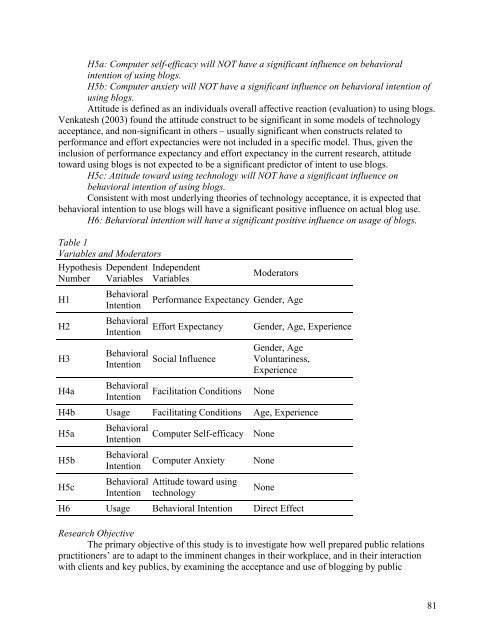2008 PROCEEDINGS - Public Relations Society of America
2008 PROCEEDINGS - Public Relations Society of America
2008 PROCEEDINGS - Public Relations Society of America
Create successful ePaper yourself
Turn your PDF publications into a flip-book with our unique Google optimized e-Paper software.
H5a: Computer self-efficacy will NOT have a significant influence on behavioral<br />
intention <strong>of</strong> using blogs.<br />
H5b: Computer anxiety will NOT have a significant influence on behavioral intention <strong>of</strong><br />
using blogs.<br />
Attitude is defined as an individuals overall affective reaction (evaluation) to using blogs.<br />
Venkatesh (2003) found the attitude construct to be significant in some models <strong>of</strong> technology<br />
acceptance, and non-significant in others – usually significant when constructs related to<br />
performance and effort expectancies were not included in a specific model. Thus, given the<br />
inclusion <strong>of</strong> performance expectancy and effort expectancy in the current research, attitude<br />
toward using blogs is not expected to be a significant predictor <strong>of</strong> intent to use blogs.<br />
H5c: Attitude toward using technology will NOT have a significant influence on<br />
behavioral intention <strong>of</strong> using blogs.<br />
Consistent with most underlying theories <strong>of</strong> technology acceptance, it is expected that<br />
behavioral intention to use blogs will have a significant positive influence on actual blog use.<br />
H6: Behavioral intention will have a significant positive influence on usage <strong>of</strong> blogs.<br />
Table 1<br />
Variables and Moderators<br />
Hypothesis<br />
Number<br />
Dependent<br />
Variables<br />
Independent<br />
Variables<br />
Moderators<br />
H1<br />
Behavioral<br />
Intention<br />
Performance Expectancy Gender, Age<br />
H2<br />
Behavioral<br />
Intention<br />
Effort Expectancy<br />
Gender, Age, Experience<br />
H3<br />
Behavioral<br />
Intention<br />
Social Influence<br />
Gender, Age<br />
Voluntariness,<br />
Experience<br />
H4a<br />
Behavioral<br />
Intention<br />
Facilitation Conditions<br />
None<br />
H4b Usage Facilitating Conditions Age, Experience<br />
H5a<br />
Behavioral<br />
Intention<br />
Computer Self-efficacy<br />
None<br />
H5b<br />
Behavioral<br />
Intention<br />
Computer Anxiety<br />
None<br />
H5c<br />
Behavioral<br />
Intention<br />
Attitude toward using<br />
technology<br />
None<br />
H6 Usage Behavioral Intention Direct Effect<br />
Research Objective<br />
The primary objective <strong>of</strong> this study is to investigate how well prepared public relations<br />
practitioners’ are to adapt to the imminent changes in their workplace, and in their interaction<br />
with clients and key publics, by examining the acceptance and use <strong>of</strong> blogging by public<br />
81
















